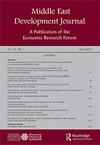How does poverty differ among refugees? Taking a gender lens to the data on Syrian refugees in Jordan
IF 0.9
Q4 DEVELOPMENT STUDIES
引用次数: 11
Abstract
ABSTRACT Many reports document the hardships experienced by refugees, highlighting that women and children are a highly vulnerable group. However, empirical analysis of how gender inequality impacts poverty among refugees is limited. We combine registration data for Syrian refugees in Jordan collected by the United Nations High Commissioner for Refugees with data from its Home Visit surveys to analyze income poverty rates among refugee households. We use an approach that captures the disruption to household structures that results from displacement to evaluate the poverty impacts, comparing refugee households with male and female principal applicants (PAs). We find that distinguishing between different types of principal applicant households is important. Half of the female PAs for nonnuclear households live below the poverty line compared to only one-fifth of male PAs for nonnuclear household. PAs who are widows and widowers also face high poverty risks. Households that have formed because of the unpredictable dynamics of forced displacement, such as unaccompanied children and single caregivers, emerge as extremely vulnerable groups. We show that differences in household composition and individual attributes of male and female PAs are not the only factors driving increased poverty risk. Gender-specific barriers which prevent women accessing labor markets are also a factor. Our findings show that gender inequality amplifies the poverty experienced by a significant number of refugees. Our approach can be used to help policy-makers design more effective programs of assistance and find durable solutions for displaced populations.难民的贫穷程度有何不同?从性别角度看待约旦境内叙利亚难民的数据
摘要许多报告记录了难民所经历的苦难,强调妇女和儿童是一个高度脆弱的群体。然而,对性别不平等如何影响难民贫困的实证分析有限。我们将联合国难民事务高级专员收集的约旦叙利亚难民登记数据与其家访调查的数据相结合,分析难民家庭的收入贫困率。我们采用了一种方法,捕捉流离失所对家庭结构的破坏,以评估贫困影响,将难民家庭与男性和女性主要申请人(PA)进行比较。我们发现,区分不同类型的主要申请人家庭很重要。非核心家庭中有一半的女性私人助理生活在贫困线以下,而非核心家庭的男性私人助理只有五分之一。作为寡妇和鳏夫的私人助理也面临着很高的贫困风险。由于不可预测的被迫流离失所动态而形成的家庭,如无人陪伴的儿童和单身照顾者,成为极其脆弱的群体。我们发现,家庭构成和男性和女性私人助理个人特征的差异并不是导致贫困风险增加的唯一因素。阻碍妇女进入劳动力市场的性别障碍也是一个因素。我们的调查结果表明,性别不平等加剧了大量难民所经历的贫困。我们的方法可以用来帮助决策者设计更有效的援助计划,并为流离失所人口找到持久的解决方案。
本文章由计算机程序翻译,如有差异,请以英文原文为准。
求助全文
约1分钟内获得全文
求助全文

 求助内容:
求助内容: 应助结果提醒方式:
应助结果提醒方式:


